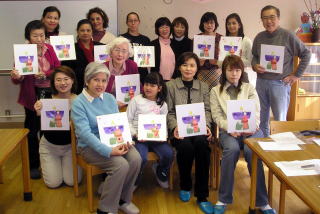No.205-5
Let’s make Ohinasama
(Girl’s doll)
♪ Akari wo tsukemasho bonbori ni ohana wo agemasho momo no hana ♪
(Let’s
light the lantern and decorate flowers for the Girl’s Festival…)
My
daughter used to sing this song when she was a little girl. I find myself
singing this song without knowing, too.
It
was such a nice spring day, with the sun shining into the classroom. 15
participants gathered to make Girl’s Festival’s dolls from pieces of
paper. I came to know the beauty of washi
(Japanese papers), its colors and softness. Since my every day life is so
busy, knowing Japanese tradition fulfilled my heart. When we made our dolls,
every doll had its own personality.
I
thank UNESCO members for preparing such a wonderful party. I look forward to
the next opportunity to understand more about Japanese culture.
Lin Lin (Taiwan, Japanese S class)
* After making paper dolls, we created a little box
from origami (Japanese paper), and put hina-arare (rice cake
cubes) in it, and celebrated Girl’s Festival. The members of International
Exchange Committee were delighted to see everyone enjoying the moment.
The Spirit of the UNESCO Art Exhibition is to be handed down to a next
generation
Art and Cultural Activity Committee
UNESCO
art exhibition, UNESCO art classes and a charity concert are handled by the Art
and Cultural Activity Committee, which changed its name from Cultural Activity
Committee last autumn. Among them, the UNESCO Art Exhibition has a special
pride and tradition which come from 47 years of history.
In
1957, only 3 years after the Meguro UNESCO Association was founded, UNESCO Art
Exhibition started as an activity of an art club. Every year, the first corner
of the exhibition is decorated by the works of art by Mr. Kizan Itaka, Jr. (an
advisor of Meguro UNESCO) and Mr. Yosei Itaka. They are native Meguro ceramists
and are deserved to be called foster parents of the exhibition. This is because
they succeeded their father, Mr. Kizan Itaka, Sr., who proposed holding an
exhibition.
In
those days, people’s lives in Japan had little time to enjoy art and culture.
Even the number of people who went to universities was limited. Many of those
who were eager to study worked during the day and attended university night
courses. People were ‘hungry’ in many ways then.
Art
club started during the early times of our association. 30 famous artists who
lived in Meguro attended the club as members. Their annual contribution was
\360. A record says that their contributions and the money donated by Mr.
Yoshizumi Yokoe, a director in charge of the art club, who was regularly
invited to exhibit his works at the Nitten (The Japan Fine Arts Exhibition),
were used to hold the exhibition.
The
members made their works of art for the exhibition in order to answer the
question, “How the world of art can cooperate with the movement of UNESCO”. And
they talked to people through their works with an idea that art can unite
people’s minds just like words do.
The
first exhibition was held successfully at Toyoko (now Tokyu) Department Store.
With this success, Meguro UNESCO Association proposed Kyoto UNESCO Association
to co-sponsor the Japan UNESCO Exhibition. The exhibition was held at
Mitsukoshi Department Store at Nihonbashi, and drew 140,000 (!) visitors, which
surprised the person in charge at the department store.
As is
told above, the UNESCO Art Exhibition used to be a place for the famous artists
to show their works of art, but since 1965, it has changed its role and became
one of the programs in Cultural Festival of Meguro City. It opened its door
widely to the general public, such as foreigners living in Japan, foreign
students, art-loving people and the youth and children from Japan and abroad.
Beyond nations and generations, it became a place for amateurs. This year was
the 39th anniversary since it belonged to the Cultural Festival of Meguro
City.
Until
Meguro Museum of Art opened, and its Kumin Gallery was offered to the UNESCO
Art Exhibition, the Welfare Center and Meguro Kumin Center were often used for
the exhibition. After the masters of the early times who loved and cherished
the exhibition passed away, the committee members were so anxious about how to
liven up the exhibition. Thanks to the artists who were watching over us from
the heaven, we found our anxiety groundless.
Fresh breeze was blown into the exhibition
from new participants, such as Mr. Ki Nimori, a teacher of stained glass
classes this year, Ms. Tomoko Kurokawa, our new member and also an artist of ‘Rozashi’,
Japanese traditional embroidery, who wishes to hand down it to children, young
artists who would shoulder the next generation and talented young children from
a studio in Meguro. Now we wish to reflect the spirit of UNESCO to the
exhibition in order to show art, instead of weapons, can contribute to the
world peace. I sincerely hope to hand down the spirit and the tradition of
UNESCO Art Exhibition to a next generation.
Yasuko Hamada, Art and Cultural Activity Committee
next page
